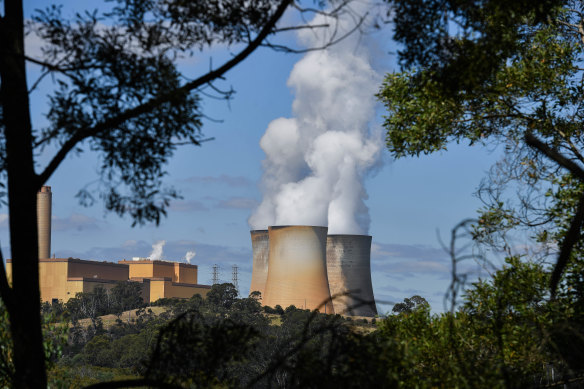East coast power shortages on the cards without new projects: AEMO
Homes and businesses in every state on Australia’s eastern seaboard are at risk of electricity shortages from 2027 as looming closures of several coal-fired power stations collide with delays in building crucial new gas and clean energy projects to replace them.
In a new report to be released on Tuesday, the Australian Energy Market Operator (AEMO) warns “material changes” to its expectations of available power supplies over coming years in Victoria, South Australia, NSW and Queensland have reinforced the urgent need for new generation plants and other key infrastructure to be approved and rolled out.

“Urgent and ongoing investment in renewable energy, long-duration storage and transmission is needed to reliably meet demand from Australian homes and businesses,” AEMO chief executive Daniel Westerman said.
Up to five-coal fired power stations, including the Yallourn generator in Victoria’s Latrobe Valley, NSW’s Liddell, Eraring and Vales Point power plants, and Queensland’s Callide B, are expected to shut down this decade, removing 13 per cent of the east-coast grid’s generating capacity.
Gaps in the market begin to emerge from 2025, AEMO warns – first in NSW due to Origin Energy’s possible closure of Eraring, then in Victoria from 2026 because of the closure of two gas-fired power stations in South Australia.
The forecast gaps will continue to widen until all mainland states connected to the east-coast grid are forecast to breach their “reliability standard” from 2027 onwards. The reliability standard is a requirement for at least 99.998 per cent of forecast customer demand to be met each year.
AEMO’s updated reliability forecasts factor in AGL’s decision to bring forward the closure of its 800-megawatt Torrens Island gas-fired power station in South Australia by several years to 2026; a one-year delay to the construction of the Snowy Hydro 2.0 pumped hydro project in NSW to 2026; and a year-long delay to the Kurri Kurri gas-fired power plant in NSW to 2024.
Delays to Snowy 2.0 have raised suggestions that Origin Energy may extend the life of Eraring beyond 2025. When it announced its intention last year to close the plant early, the company gave a commitment it would continue evaluating market conditions and not withdraw the plant in 2025 unless the grid was equipped to handle its exit.
“Eraring may need to play an important capacity role,” analysts at investment bank Macquarie said last week.
As the clean energy transition gathers pace, the roll-out of large-scale wind and solar farms coupled with Australians’ booming uptake of rooftop solar panels have been radically reshaping the market and squeezing out fossil fuels.
Renewable energy generation hit a record high in the final three months of 2022, supplying on average 40 per cent of the grid’s power during quarter, beating the previous record of 35 per cent set in the same period of the prior year.
Because electricity production is a dominant source of Australia’s emissions, reducing output from coal plants will help sharply reduce the national carbon footprint and help reach the federal government’s commitment to cut national greenhouse gas emissions by 42 per cent by 2030.
The Albanese government’s commitment includes a target for the grid to source 82 per cent of its power from renewable sources this decade, and is being supported by a $20 billion “Rewiring the Nation” fund to modernise the grid and develop new transmission lines to better-enable the flow of energy around the country and bolster reliability.
However, AEMO is becoming increasingly concerned about the slow roll-out of new “firming” generation such as pumped hydro, gas and long-duration batteries, which will be vital to supporting renewable energy and preventing blackouts when the wind isn’t blowing and the sun isn’t shining.
“Investment in firming generation … is critical to complement our growing fleet of weather dependent renewable generation to meet electricity demand without coal generation,” Westerman said.
The calls for new gas-fired power generation to shore up the grid could add to the political challenge for Labor, which depends on support from the Greens to pass its new industrial emissions-reduction policy, known as the safeguard mechanism. The Greens have been pressuring Labor to commit to stopping new gas fields as a condition of their support.
Australia narrowly averted blackouts last year as several coal-fired stations suffered unexpected breakdowns and others withdrew supplies, at the same time as gas-fired generators faced soaring fuel prices due to the fallout from the war in Ukraine.
Tony Wood, energy director at the Grattan Institute, a prominent policy think tank, said there were potentially significant gaps emerging in the market, but noted that there was also a large disparity between new projects that “may” come online and projects that were far-enough advanced to be deemed committed by AEMO.
Of 209 gigawatts of new projects, just 10 gigawatts is considered committed.
“The piece that makes it difficult is whether these projects are ‘possibles’ but not ‘probables’ and what the likelihood is of these things going ahead?” Wood said.
“Calling it a wake-up call is probably strong, but there are some big gaps emerging here … and there are lots of possibilities.”
The Business Briefing newsletter delivers major stories, exclusive coverage and expert opinion. Sign up to get it every weekday morning.
Most Viewed in Business
Source: Thanks smh.com